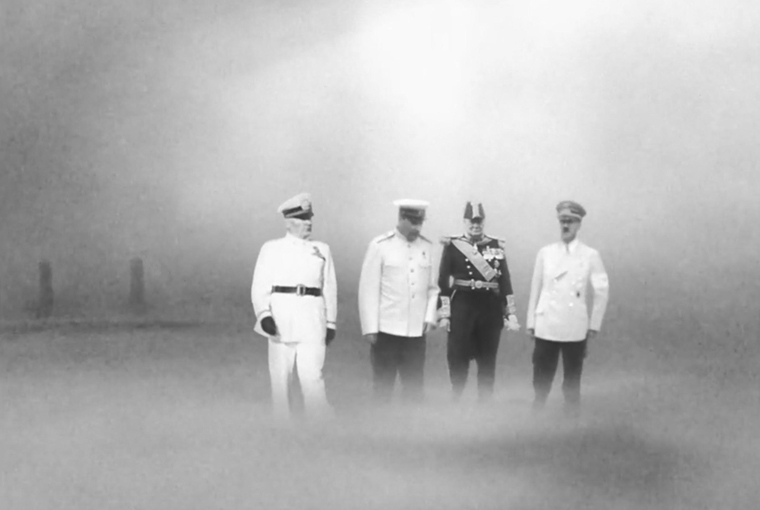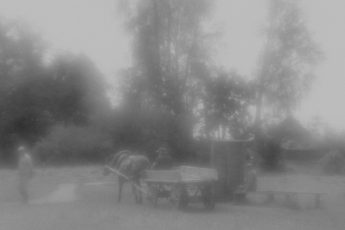Is There Rest for the Wicked in a Deep-Fake Purgatory?
Alexander Sokurov’s Fairytale (Skazka, 2022)
Vol. 133 (March 2023) by Antonis Lagarias
According to the Catholic Church, those who die in God’s grace imperfectly purified have to undergo a special purification process after death so as to attain the holiness required to enter heaven and join the rest of the saved souls. For Catholics, this purgatorial process is one of suffering, a suffering of love to be precise, since those not-yet-holy souls remain in God’s favor and are guaranteed access to heaven. Still, the process is often associated with pain that is both mental (due to the absence of God) and physical (due to extreme cold or fire). To describe the nature of purgatorial suffering, Pope Benedict XVI suggested, in a very Sartrean way,1 that purgatory is the full experience of the gaze of Jesus, which takes the form of a blessed burning.2 Not to be confused with the punishment of the damned, this state of suffering is intermediate between heaven and hell, comparable to a waiting room for heaven, a final purification of the elect. On the other hand, for the Orthodox Church, purgatory suffering is a Western invention. For Orthodox Christians, before the final admission to heaven that takes place on the Last Day (Judgment Day), there is an intermediate after-death state for all souls (except for a few holy exceptions that enter heaven immediately upon their death), aimed to perfect and divinize them in a process of growth rather than suffering.
This premise traverses Alexander Sokurov’s Fairytale, a film that imagines and beautifully animates a waiting area for souls wandering in a vast ruined landscape. Once there, the souls all converse regularly with God in front of an oversized door, demanding to be let in. The catch is that those souls almost exclusively belong to the four main protagonists of World War II: Hitler, Mussolini, Stalin, and Churchill. Sokurov uses CGI technology to reanimate the bodies of the dead from real photographs, resulting in an uncanny effect. The characters appear as technological ghosts, realistic yet incomplete, distorted and fleeting. Different versions of each character err in a waiting space composed of Roman ruins devoured by growing trees, large misty forests reminiscent of northern folk stories, and monumental constructions amidst an apocalyptic wasteland. The characters freely converse with each other, but also with different versions of themselves, since multiple versions of the same character with constantly changing appearance coexist in that space (they appear in casual clothes and official military uniforms, holding changing objects). Their discussions seem to be stuck in an ever-repeating circle, structured around the same obsessions. They complain about their body odor and the quality of their uniform, they brag about past achievements, and they regret the most trivial details about their earthly life, such as their choice of sexual partners. On the contrary, their great political projects, crimes or ideology are hardly mentioned. What is surprising, though, is the absence of animosity towards their previous enemies. Even if they appear bitter, petty, and borderline senile, they seem to have accepted each other’s company other as they are now in the same boat, stuck waiting for their admission to heaven.
In their constant demands to be let into heaven, God’s only response is a benevolent “soon”. Of course, “soon” is hardly a time-specific answer, so one can assume that their punishment takes the form of a slow process that will ultimately drive them insane. As with Jean-Paul Sartre’s characters, post-mortem interactions include variations of looking and being looked at. Sokurov, however, suggests that even there, in the midst of a post-mortem ruined landscape, those people remain blind, still drunk with their past authority, showing no sign of remorse. Even from the Orthodox point of view, no personal “growth” is to be observed. Of course, that is to be expected – who would truly appreciate seeing a remorseful, considerate Adolf Hitler on screen?
It is hard to miss a straightforward symbolism and moralism. Stripped of their power and authority, the political figures whose actions shaped the course of the 20th century become child-like, a laughingstock for the viewers in a (perhaps cathartic?) attempt to de-throne and ridicule them. Away from the human world, their narcissism and blindness become all the more apparent. The film even features a scene with a windmill to underscore their obsessive delusions. If the aim was to ridicule the four leaders, however, one could nevertheless question the director’s intentions. Laughing at Hitler’s obsession with his sex partner, Stalin’s body odor that is reminiscent of sheep, Mussolini’s toilet break, or Churchill’s fanatical devotion to the Queen, is all nice and easy today, but why do the human flaws of those historical leaders matter? Even if de-glorifying leaders and reveling that they are (also) human, can have a political effect at a time when power is centralized and concentrated in one (quasi-divine) figure, one could argue that parody and farce only have significant political force when turned against their contemporaries. In retrospect, after death in this case, it is easy to reach common agreement. Who would be shocked at, or even interested in seeing a delusional Hitler still preach to a mass of suffering souls from the peak of a monumental construction after his death? After all, films did employ parody to, partly, ridicule and reveal the human flows of authoritarian figures during World War II as early as 1939 (when Charlie Chaplin’s The Great Dictator was released) and 1942 (the year that Ernst Lubitsch’s To Be or Not to Be came out).
In the midst of the geopolitical tensions that followed Russia’s invasion of Ukraine, one would, instead, expect political criticism aimed at present autocratic leaders responsible for contemporary bloodshed. In comparison, using WWII leaders to comment on the inevitable failure of all authority and power, feels like an anodyne choice and requires a significant logical leap (even within the realm of atemporal divine symbolism and indirect representation) to link the film’s political ambitions with current events and thus initiate a discussion about the fading of power or evil. Worse, this line of thought may lead to an eventual redemption or forgiveness, as Napoleon can be seen on the other side of heaven’s door, a fact that suggests that, indeed, there is place for military leaders responsible for international bloodshed in heaven. To suggest that authoritative leaders are a horrible yet necessary evil, and that they (too) have a right to eternal salvation (whatever form this may take) is, to say the least, a poorly timed argument at a moment of increased war tensions.
The film, however, has more to offer than a moralist reading on political power. One could suggest a more meaningful interpretation that has to do with its technique. The ability to extract human figures from historical photographs and animate them employing deep-fake CGI technology is a technique that invites us to reflect on how we remember events. The devastated Roman ruins devoured by trees and mist and the unusual bare landscape deprived of references, stand for a failing collective memory, a past that rapidly degenerates, leaving behind only fragments of events, blurry images, hushed voices, and partial narratives. Like the ruins that they are surrounded with, the reanimated leaders are transformed from figures brimming with authority to brief legends, before finally turning into harmless ghosts, silly and childlike, that fade with time. Time, here, is a merciless constant that traverses both people and landscape, corrupting and erasing everything it touches. The film seems to question, more than anything, what will be left of history once enough time has passed, and once the living have decided to “move on” and preoccupy themselves with other activities than remembrance.
Towards the end, the film includes a long scene where thousands of people gather at the feet of the four leaders who stand atop a monumental building. Little by little, the people are transformed into a faceless sea that looks equally wild and sorrowful. Individual suffering will soon be lost in collective bliss, Sokurov suggests, but arguably this can equally be said for the rest of memory. Jesus Christ, in whose name countless crimes have been committed over the course of history, makes a brief appearance, also trapped in heaven’s waiting area. Could it be that the fate of all horrors, even those of World War II, is to be eventually forgotten, replaced by new ones in our collective memory? The film certainly suggests it could, and once that happens, the four leaders, like all leaders of the past, will finally be allowed through Sokurov’s great door.
References
- 1.In his play Huis Clos, Jean-Paul Sartre imagines his version of hell as a place where one is unable to close one’s eyes (blinking is physically impossible), sleep, or avoid the gaze of the other damned souls, thus being sentenced to an eternal coexistence.
- 2.In his encyclical Spe Salvi, Pope Benedict XVI writes, “Some recent theologians are of the opinion that the fire which both burns and saves is Christ himself, the Judge and Saviour. The encounter with him is the decisive act of judgement. Before his gaze all falsehood melts away […]. His gaze, the touch of his heart heals us through an undeniably painful transformation `as through fire’. But it is a blessed pain […]’’. See the excerpt of Encyclicals of Benedict XVI published on https://aleteia.org/2017/11/02/benedict-xvis-teaching-on-purgatory [Accressed on 4 May 2023].




Leave a Comment